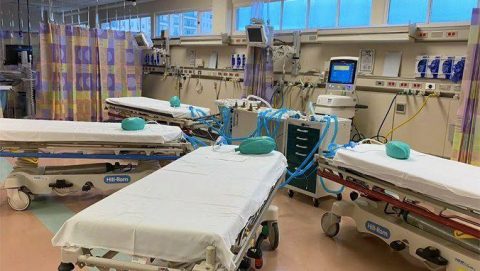
By Alfred Acenas
EBC Hawaii Bureau
HONOLULU, HAWAII (Eagle News) – The University of Hawaii (UH) John A. Burns School of Medicine (JABSOM) announced an innovative technique that can treat up to four patients with a single ventilator, thereby improving that State’s efficiency of its resources, as well as increasing capacity to save more lives from the novel coronavirus 2019 (COVID-19).
The five-member team working on the new method includes UH mechanical engineering associate professors A. Zachary Trimble and Scott Miller; Brennan Yamamoto, a UH mechanical engineering Ph.D. graduate and researcher for the UH Applied Research Laboratory; Russell Woo, Kapiʻolani Medical Center pediatric surgeon and JABSOM associate professor of surgery; and project founder Donald Gaucher, an anesthesiologist at Straub Medical Center.
“The quad-split ventilator system allows four patients to be ventilated off one ventilator, each with their own different minute ventilation,” Gaucher said.
Hawaii Lieutenant Governor Josh Green, who is also a practicing physician, said there are about 535 ventilators in the state with about 15 percent currently in use. He indicated this new technique would be implemented only in an emergency if all ventilation capacity has been used.
“That’s a huge difference. Often, intensive care units are clustered so that you can get beds near one another,” Green said. “We have our Army Corps of Engineers also looking at some additional facilities, and those facilities will be designed with this kind of technology in mind so that if we did have to couple people onto a ventilator or bring people into close contact, this of course in a crisis circumstance, we could do it.”
The Hawaii-based research team acknowledged that other doctors and experts worldwide are also working on ways to treat more than one patient with a single ventilator. One challenge they all needed to overcome was to institute safety measures to prevent cross-contamination between patients.
“There are medical grade biofilters [a filter designed to remove 99.97 percent of airborne particles, including biomaterials like bacteria and viruses, measuring 0.3 micrometers or greater in diameter passing through it] in every patient limb in both the inspiration and expiration sides, and there are anti-backflow valves in both inspiration and expiration sides, which limit the flow between patients. Thus, what limited flow that may be shared between patients is filtered,” Trimble explained.
The team added that this technique allows doctors worldwide to make modifications because the shared ventilator system is sourced by parts they can find at the local economy.
As for the way forward, the team is conducting additional testing to improve the system before the need becomes critical in Hawaii.
“This is not an approved use of the ventilator in an ideal situation. I will spend more time studying this system. However, time is of the essence,” Gaucher stressed.
Trimble agreed that this was not the first choice in treating patients who need a ventilator.
“This solution, as any sharing solution, is only in an absolute emergency situation when all ventilation capacity has been used up, there’s no more ventilation capacity. So, if we need the ability to ventilate people, this would be an emergency solution,” Trimble stated.
“I have a strong feeling that this department is in line for the department of the year award because of COVID-19 and it’s a pretty great thing to see. I’m really pleased,” Lieutenant Governor Green remarked. “I like to see the partnership that will ensue from the perspective of engineering to JABSOM to, of course, the Healthcare Association of Hawaii. All these people, we’re able to bring them together.”
(Eagle News Service)
